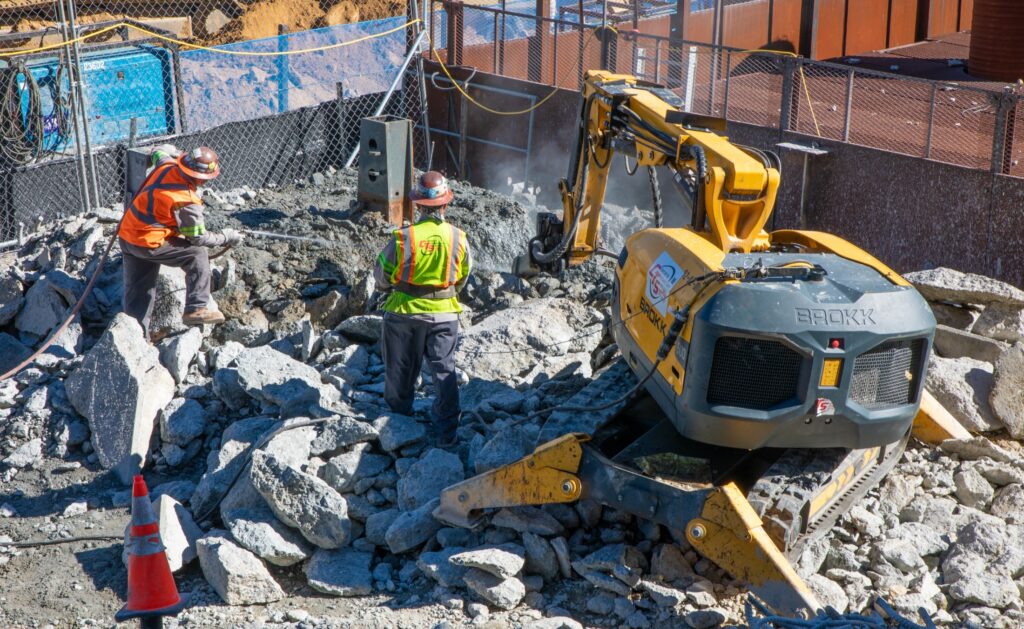A crew works on a section of the Purple Line in downtown Bethesda, in this file photo from 2022. Photo courtesy Maryland Transit Solutions.
Recently, the Maryland Department of Transportation (MDOT) announced $1.3 billion in cuts in its draft six-year Consolidated Transportation Plan (CTP). Factors noted by MDOT include the inflationary costs of construction as well as declining gas tax revenues.
There are calls for more money, but in the big picture, just throwing more money at the problem without prioritization won’t solve the long-term challenge.
Maryland and the nation simply cannot afford to continue building new highways and other infrastructure that fuel spread-out, sprawling patterns of development, while also trying to maintain and replace existing infrastructure, including aging roads, bridges, transit and other public facilities. This is especially true in this age of climate change.
When your home’s roof is leaking and your family budget is tight, you don’t add a new addition to your house instead of making needed repairs and preparing for the next big storm. The same must be true for the state.
Gov. Wes Moore is standing up for sustainable growth, and MDOT can support this by prioritizing fix-it-first infrastructure investments and ensuring existing roads, bridges and transit systems can survive the effects of climate change – flooding, heat and sea level rise. They must also prioritize investment in transit and transit-oriented development to reduce emissions.
MDOT’s draft CTP is a mixed bag. It proposes cuts for some highway and arterial expansion and costly new interchanges, but also proposes cuts to road and bridge rehabilitation programs. The department is working on transforming some arterials into safer roads with bike and bus lanes, but not allocating enough. MDOT is locking in capital funding for Metro and for replacing some ancient MTA light rail vehicles, but the Central Maryland Transportation Alliance (CMTA) has flagged the proposed $670 million cut to the Maryland Transit Administration’s (MTA) six-year capital budget, primarily affecting essential maintenance and repair efforts.
When your home’s roof is leaking and your family budget is tight, you don’t add a new addition to your house instead of making needed repairs and preparing for the next big storm. The same must be true for the state.
– Stewart Schwartz and Bill Pugh
CMTA notes that the MTA cuts appear to violate the Transit Safety and Investment Act, passed three years ago to address MTA’s repair backlog. The act requires MDOT to budget at least $450 million in both FY 2025 and FY 2026 for MTA’s state of good repair, but MDOT is allocating just $336 million and $376 million in each year. Upgrading MTA facilities is essential, because revitalization of Baltimore depends on maintaining a modern, reliable transit system.
MDOT should find cuts to additional highway expansion projects in order to meet its state of good repair obligations.
It may be too late, but the huge allocation – $174 million for the Maryland Route 4/Suitland Parkway interchange in Prince George’s County, on top of $95 million already spent, should be reconsidered. Paying $269 million for just one interchange, to subsidize a development far from frequent transit, should give us pause. It shows the burden on our transportation budget caused by poor local land use decisions.
Instead, the most cost-effective and sustainable approach would be to add housing near transit, jobs and services, saving both the state and households money on transportation costs. Maryland’s longstanding smart growth goals, being revitalized under the governor’s Sustainable Growth agenda, if fully implemented, would help address the land-use root cause of Maryland’s transportation challenges.
To this end, the state is supporting investment in the Metro Blue Line corridor in Prince George’s, and MDOT is seeking to prioritize transit-oriented development (TOD) at light rail and MARC stations, recently releasing a plan for TOD on the Penn Line.
Investing in walkable, transit-friendly communities with abundant housing options and in Maryland’s historic Main Street communities is a win-win – for livability, sustainability, state and local finances, and healthy infrastructure. The Coalition for Smarter Growth makes this case in our Blueprint for a Better Region.
However, proposals to increase transportation funding in Maryland, if made without fix-it-first provisions and without the governor’s “whole-of-government” approach to climate change, would perpetuate the problem the state finds itself in now. Legislation like the Transportation and Climate Alignment Act would ensure transportation investments reduce climate emissions and provide affordable travel options.
MDOT should also refine its legally required project prioritization process to ensure projects meet goals for sustainable land use, job accessibility, emissions reduction, safety and equity.
Applied nationally, this approach would save local, state and federal governments $2 trillion by 2050, according to the Institute for Transportation and Development Policy. Those savings can be used to make existing infrastructure and communities more resilient to the impacts of climate change.
In short, sustainable land use, transit, and a fix-it-first and resilience-first approach to Maryland transportation and infrastructure spending is essential for Maryland’s future.

